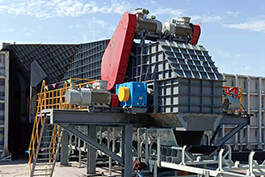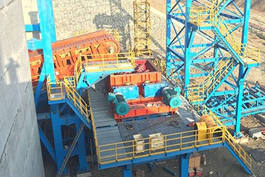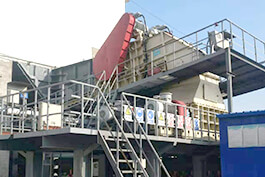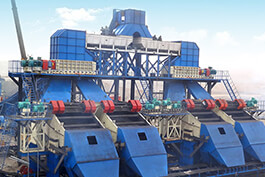Introduce
Crushing is a very important operation link in the processes of coal mining, washing and processing, and final use. Its purpose is to increase the specific surface area of the material, dissociate the symbiotes in the minerals, prepare for further processing of the raw materials or facilitate their use. Crushers can be classified by structural form into jaw crushers, hammer crushers, impact crushers, roll crushers, mineral sizers, etc.
According to the particle size requirements of the product after crushing, it can be classified into coarse crushing, medium crushing, fine crushing and fine crushing crushers. Coal preparation plants can crush large pieces of raw coal to the particle size required by dry separation, flotation, gravity separation and other separation processes.
Whether it is the initial processing of raw coal or during the coal preparation process, crushing is a very crucial step. It directly affects the investment in the subsequent processing of coal and the sales of products, and is related to the economic benefits of coal enterprises. Therefore, It is particularly important to make the correct selection of the crusher.
Types of crushers for coal preparation
Roll crusher
There are two types of crushers used in coal preparation plants: single-toothed roller crushers and double-toothed roller crushers. Currently, the double-toothed roller crusher is the most commonly used. The advantages of the toothed roller crusher are: simple structure, reliable performance, large production capacity, and low degree of pulverization of crushed products. Its drawback is that the roller teeth are prone to wear.
Mineral sizer
Mineral sizer is an improved version of the conventional Roll crusher. Unlike roll crusher, the composition structure of mineral sizer consists of two sets of motors + hydraulic couplings + reducers + couplings, which are respectively connected to two crushing toothed rollers. The gap between the two toothed rollers can be adjusted according to the customer's requirements. Let the materials with particle sizes smaller than the gap between the toothed rollers fall directly. This not only increases the processing capacity but also minimizes the over-crushing of the materials to the greatest extent.
Impact crusher
The impact crusher breaks down materials by the multiple impacts of hammers and impact plates, causing the materials to shatter along the fragile surfaces. It is suitable for crushing brittle materials. Its advantages include high crushing efficiency, low energy consumption, large output, uniform product particle size, large crushing ratio, and simple structure, etc. Its main disadvantages are that the hammerhead wears out quickly and generates a lot of dust.
Jaw crusher
The jaw crusher is a crushing machine mainly based on the extrusion method. It is suitable for crushing raw coal with a high content of hard crushed stone or a large amount of pyrite. Its advantages are reliable operation and the ability to handle the crushing of hard materials. Its disadvantage is that due to intermittent operation and self-weight discharge, its processing capacity is low, and the amount of pulverized coal produced during coal crushing is more than that of the toothed roller crusher.
Hammer crusher
The hammer crusher uses the striking effect of high-speed rotating hammer heads for crushing. It is suitable for crushing brittle materials. Its advantages are simple structure, compact structure, large production capacity, large crushing ratio and low power consumption. Its main drawback is that when the moisture content of the material is high, the grate bars are prone to clogging, and the wear of the hammer heads and grate bars is also relatively fast.
.jpg)
Selection of crushers for coal preparation
The basic requirements for crushers in coal preparation plants are: under the premise of maintaining the normal particle size of the output, over-crushing should be minimized as much as possible to avoid adding a burden to the coal slime water system.
Selection of non-toothed silver crushers
Due to the severe over-crushing phenomenon of jaw crushers, hammer crushers and impact crushers, etc., the above three types of crushers should be avoided as much as possible.
The selection of Mineral sizer
At present, the most widely used material in design is Mineral sizer, which is suitable for crushing large pieces of raw coal. Unlike traditional toothed roller crushers that rely on impact and compression for crushing, Mineral sizer fully exploits the characteristic that the compressive strength > shear strength > tensile strength of materials such as coal. It uses the combined action of shearing and stretching to crush the materials. Meanwhile, the linear velocities at each contact point between the materials and the roller teeth are different, thus the crushing operation has a certain degree of impact. It is also conducive to the crushing of materials.
Advantages of Mineral sizer
Mineral sizer is used in coal preparation plants and has the following outstanding advantages:
①Due to the adoption of low speed and special tooth shape, the tooth roller functions like a rotating screen during operation. Particles smaller than the discharge particle size can pass through directly without the need for crushing, thus resulting in less overcrushing and over-particle size of the material.
②If the system takes effective measures to remove iron and impurities, raw coal can be directly graded and crushed without pre-screening, thus simplifying the process flow. Therefore, when coal preparation plants select crushers, Mineral sizer should be given priority.
The classification and application scope of Mineral sizer
Mineral sizer, based on the form of crushed particle size, can be divided into two types: primary mineral sizer and secondary mineral sizer. Their application scopes are introduced as follows:
Primary Mineral Sizer
Particle size of processed materials
Mainly responsible for the initial crushing work and handling large pieces of raw ore that have just been mined. It usually accepts materials with larger feed sizes. Primary Mineral Sizer can accept feed block sizes up to 1200mm and can crush them to about 300mm.
Applicable scenarios
Due to its compact structure and lower height than other types of primary crushers, it is suitable for mining scenarios with limited head space, such as underground mines.
Compatible materials
It can handle a variety of minerals, such as copper, iron, gold, nickel ores and coal, etc. It is particularly good at processing viscous materials with high clay content and can solve the problem that traditional primary crushers like jaw and rotary crushers have difficulty handling materials containing clay.
Secondary Mineral Sizer
Particle size of processed materials
It is used to process minerals that have become smaller after primary crushing, further crushing them into finer particle sizes to meet the requirements of subsequent processing or transportation. Secondary Mineral Sizer further crushes the coal that is approximately 400mm after primary crushing to a finished particle size of 100mm.
Applicable scenarios
It is often configured after the Primary Mineral Sizer and is widely used in places such as concentrators and coal processing plants where multi-stage crushing processes are required. It can be flexibly arranged and combined with other equipment to build a crushing production line based on production capacity, output particle size requirements, etc.
Compatible materials
For most common minerals such as coal, salt, gypsum, phosphate, limestone, bauxite and petroleum coke that have undergone primary crushing, secondary fine crushing can be carried out.
Conclusion
Because mineral sizer excels in controlling the upper limit of particle size and overgrinding rate, it has been widely applied in coal preparation plants. Crushing is a crucial step in the coal preparation process and an important means to enhance the economic indicators of coal preparation plants.


.jpg)
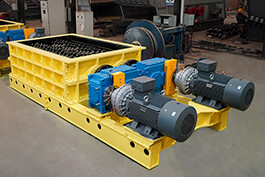
.jpg)
